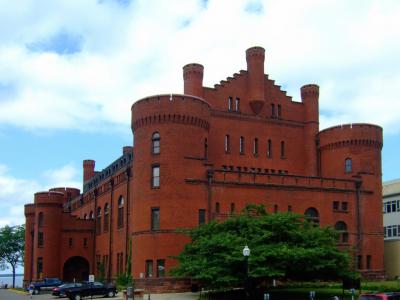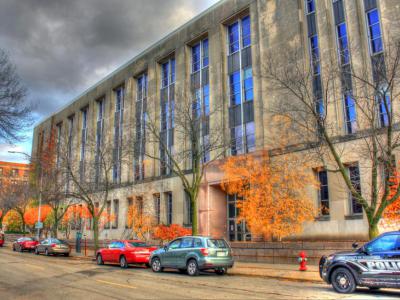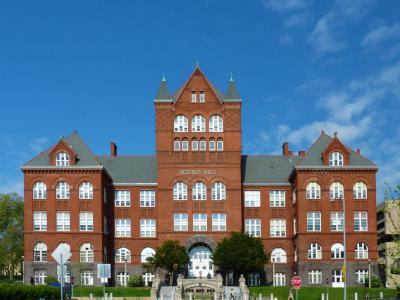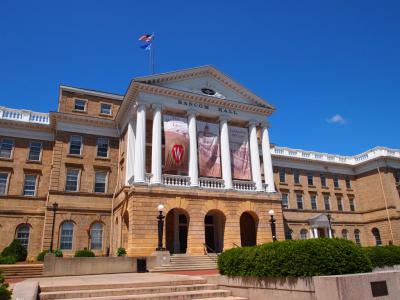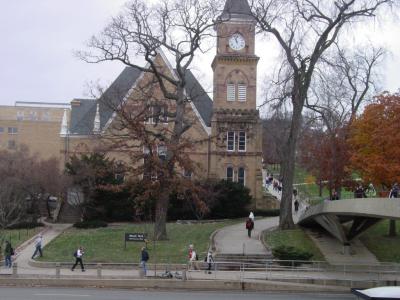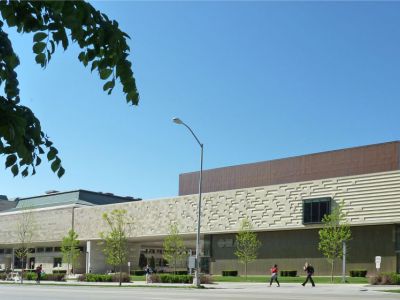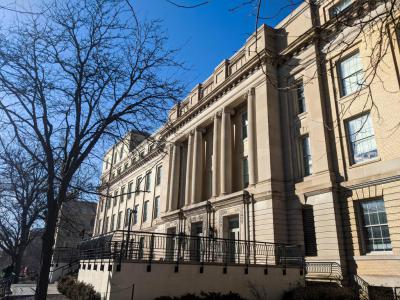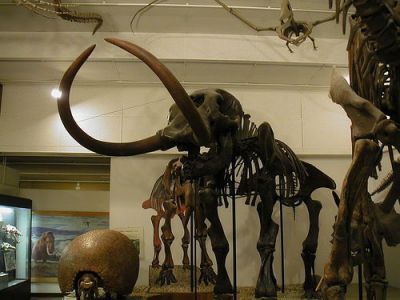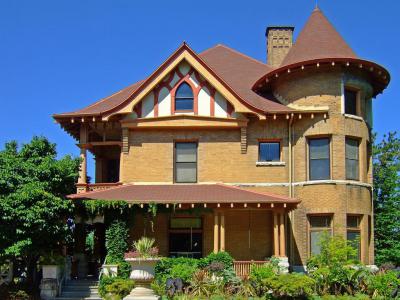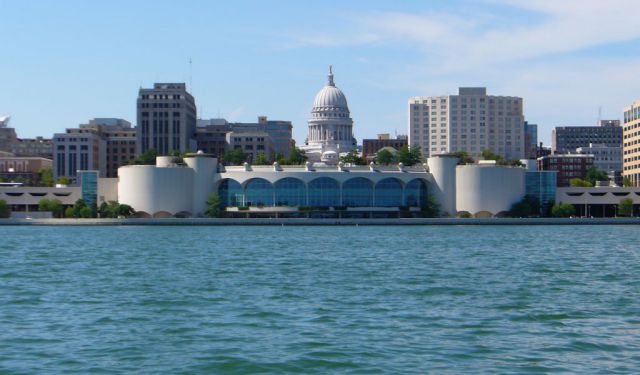
University of Wisconsin-Madison Walking Tour (Self Guided), Madison
Founded the same year as Wisconsin achieved its statehood – 1848, the University of Wisconsin in Madison (often simply referred to as UW Madison) is the oldest public university in the state and the flagship campus of the University of Wisconsin System. The UW Madison campus, located on the shores of Lake Mendota, includes four National Historic Landmarks. Complete with these and a sweeping view of the lake as a bonus, it has been repeatedly ranked as one of the most beautiful college campuses in the United States.
One of the most iconic spots here is the Memorial Union and Terrace. The Memorial Union is a historic building that serves as a hub for student activities and features a picturesque terrace overlooking Lake Mendota. Students and visitors alike can relax by the lake, enjoy live music, or grab a bite to eat.
Another notable campus site is the so-called Red Gym, officially known as the Armory and Gymnasium. This historic structure houses various student services related facilities and is a prominent part of the university's history.
The Memorial Library is a massive library with extensive collections, making it a vital resource for researchers. It's a place where many students spend countless hours studying and conducting research.
Science enthusiasts will appreciate the University of Wisconsin Science Hall, a center for scientific exploration and discovery. Bascom Hill and Bascom Hall, the administrative heart of the university located at the top of the hill, offer stunning views of the campus and the state capitol.It
The School of Music is home to Music Hall, where talented musicians and performers showcase their skills. Art lovers can explore the Chazen Museum of Art, which houses an impressive collection of artworks.
Chamberlin Hall is home to the Physics Museum, where you can explore fascinating physics exhibits. Meanwhile, the Geology Museum offers a glimpse into the Earth's geological history.
Sports enthusiasts can cheer on the Wisconsin Badgers at Camp Randall Stadium, where exciting college football games are held. And for those seeking a tranquil escape, Allen Centennial Gardens is a beautiful botanical garden on campus.
If you're ever in Madison, be sure to visit UW Madison and experience its vibrant campus life firsthand. Whether you're interested in academics, the arts, or sports, you'll enjoy the time spent at this outstanding institution all the same.
One of the most iconic spots here is the Memorial Union and Terrace. The Memorial Union is a historic building that serves as a hub for student activities and features a picturesque terrace overlooking Lake Mendota. Students and visitors alike can relax by the lake, enjoy live music, or grab a bite to eat.
Another notable campus site is the so-called Red Gym, officially known as the Armory and Gymnasium. This historic structure houses various student services related facilities and is a prominent part of the university's history.
The Memorial Library is a massive library with extensive collections, making it a vital resource for researchers. It's a place where many students spend countless hours studying and conducting research.
Science enthusiasts will appreciate the University of Wisconsin Science Hall, a center for scientific exploration and discovery. Bascom Hill and Bascom Hall, the administrative heart of the university located at the top of the hill, offer stunning views of the campus and the state capitol.It
The School of Music is home to Music Hall, where talented musicians and performers showcase their skills. Art lovers can explore the Chazen Museum of Art, which houses an impressive collection of artworks.
Chamberlin Hall is home to the Physics Museum, where you can explore fascinating physics exhibits. Meanwhile, the Geology Museum offers a glimpse into the Earth's geological history.
Sports enthusiasts can cheer on the Wisconsin Badgers at Camp Randall Stadium, where exciting college football games are held. And for those seeking a tranquil escape, Allen Centennial Gardens is a beautiful botanical garden on campus.
If you're ever in Madison, be sure to visit UW Madison and experience its vibrant campus life firsthand. Whether you're interested in academics, the arts, or sports, you'll enjoy the time spent at this outstanding institution all the same.
How it works: Download the app "GPSmyCity: Walks in 1K+ Cities" from Apple App Store or Google Play Store to your mobile phone or tablet. The app turns your mobile device into a personal tour guide and its built-in GPS navigation functions guide you from one tour stop to next. The app works offline, so no data plan is needed when traveling abroad.
University of Wisconsin-Madison Walking Tour Map






Guide Name: University of Wisconsin-Madison Walking Tour
Guide Location: USA » Madison (See other walking tours in Madison)
Guide Type: Self-guided Walking Tour (Sightseeing)
# of Attractions: 11
Tour Duration: 2 Hour(s)
Travel Distance: 3.5 Km or 2.2 Miles
Author: DanaU
Sight(s) Featured in This Guide:
Guide Location: USA » Madison (See other walking tours in Madison)
Guide Type: Self-guided Walking Tour (Sightseeing)
# of Attractions: 11
Tour Duration: 2 Hour(s)
Travel Distance: 3.5 Km or 2.2 Miles
Author: DanaU
Sight(s) Featured in This Guide:
- Memorial Union and Terrace
- Red Gym
- Memorial Library
- University of Wisconsin Science Hall
- Bascom Hill and Bascom Hall
- Music Hall at School of Music
- Chazen Museum of Art
- Chamberlin Hall and Physics Museum
- Geology Museum
- Camp Randall Stadium
- Allen Centennial Gardens
1) Memorial Union and Terrace (must see)
Memorial Union and Terrace is one of the best gathering spots in Madison with stunning lake and sunset views. The sunburst chairs are a local icon and provide a great place to sit that is comfortable and perfect for people-watching. Visitors will easily see why this spot is a campus favorite at the University of Wisconsin. Even members of the public unaffiliated with the school enjoy the terrace because of everything that it offers.
This terrace is a great place is enjoy some bratwurst, one of Madison's favorite snacks. There is also beer available, and you'll enjoy the relaxed setting. Another great thing about eating here is that you can also enjoy the popular ice cream from Babcock. This ice cream is a very popular local treat.
Memorial Union is also a major center for popular on-campus activities. Ghost tours often make their way through this part of the campus. Another activity that you might have the opportunity to witness is a scavenger hunt, and either of these two activities is something that you may want to consider. There is usually some interesting going on nearby that s worth your time.
Live entertainment is also popular here, especially during the summer. These artists include student and other local acts, and you're sure to have a great time, regardless. There is also a walking path that goes around the lake. When you take a walk around the lake, you will be able to enjoy some beautiful views in a serene setting.
This terrace is a great place is enjoy some bratwurst, one of Madison's favorite snacks. There is also beer available, and you'll enjoy the relaxed setting. Another great thing about eating here is that you can also enjoy the popular ice cream from Babcock. This ice cream is a very popular local treat.
Memorial Union is also a major center for popular on-campus activities. Ghost tours often make their way through this part of the campus. Another activity that you might have the opportunity to witness is a scavenger hunt, and either of these two activities is something that you may want to consider. There is usually some interesting going on nearby that s worth your time.
Live entertainment is also popular here, especially during the summer. These artists include student and other local acts, and you're sure to have a great time, regardless. There is also a walking path that goes around the lake. When you take a walk around the lake, you will be able to enjoy some beautiful views in a serene setting.
2) Red Gym
The University of Wisconsin Armory and Gymnasium, also called "the Red Gym" or “Bowser’s Castle,” is a building on the campus of University of Wisconsin–Madison. It was originally used as a combination gymnasium and armory beginning in 1894. Designed in the Romanesque revival style, it resembles a red brick castle. It is situated on the shores of Lake Mendota, overlooking Library Mall, and adjacent to Memorial Union.
The architects, Conover and Porter, designed it with a dual purpose in mind: armory and gymnasium. Modifications were made to the plans when a new university president, Charles Adams, insisted that the second floor be capable of accommodating large assemblies. Construction began in fall, 1892, and was completed in September, 1894.
As originally constructed, the first floor of the Red Gym held military offices, an artillery drill room, bowling alleys, a locker room, and a swimming tank. The second floor contained a drill hall wide enough to permit a four-column battalion. The third floor was occupied by the gymnasium, which contained a baseball cage, gymnastic apparatus, and rowing machines. T
With diminishing use of the building after World War II, plans were made to demolish it; however, popular sentiment delayed those plans. When a new gym was constructed on the west end of campus in 1963, the building was again slated for demolition, and again received a reprieve. In the 1960s, it once again saw military use as ROTC headquarters. A firebomb aimed at the building by anti-war protesters in 1970 resulted in severe damage, which was repaired. Since then, the building has seen various administrative uses; it currently houses student services-related offices and centers.
The University of Wisconsin Armory and Gymnasium was declared a National Historic Landmark in 1993.
The architects, Conover and Porter, designed it with a dual purpose in mind: armory and gymnasium. Modifications were made to the plans when a new university president, Charles Adams, insisted that the second floor be capable of accommodating large assemblies. Construction began in fall, 1892, and was completed in September, 1894.
As originally constructed, the first floor of the Red Gym held military offices, an artillery drill room, bowling alleys, a locker room, and a swimming tank. The second floor contained a drill hall wide enough to permit a four-column battalion. The third floor was occupied by the gymnasium, which contained a baseball cage, gymnastic apparatus, and rowing machines. T
With diminishing use of the building after World War II, plans were made to demolish it; however, popular sentiment delayed those plans. When a new gym was constructed on the west end of campus in 1963, the building was again slated for demolition, and again received a reprieve. In the 1960s, it once again saw military use as ROTC headquarters. A firebomb aimed at the building by anti-war protesters in 1970 resulted in severe damage, which was repaired. Since then, the building has seen various administrative uses; it currently houses student services-related offices and centers.
The University of Wisconsin Armory and Gymnasium was declared a National Historic Landmark in 1993.
Sight description based on Wikipedia.
3) Memorial Library
Memorial Library in Madison is on the University of Wisconsin campus and offers a great environment for all visitors. There are five floors of unique collections that visitors can explore, and there are also events that are worthy of your time. Visiting this library will give you plenty to do during your time here.
Visit the Mills Music Library to learn more about the musical collections. English literature enthusiasts will enjoy seeing what the Shakespeare Collection has to offer. There is an East European Studies collection, as well as an East Asian Reading Room and Collection, and a Greek & Latin Reading Room.
This library offers workshops and events that you might find interesting. Some of the most popular workshops involve introductions to programming and other computer-related topics. Special events may involve books, art, and cultural activities. Many of these events are perfect for people of all ages and interest levels.
Visit the Mills Music Library to learn more about the musical collections. English literature enthusiasts will enjoy seeing what the Shakespeare Collection has to offer. There is an East European Studies collection, as well as an East Asian Reading Room and Collection, and a Greek & Latin Reading Room.
This library offers workshops and events that you might find interesting. Some of the most popular workshops involve introductions to programming and other computer-related topics. Special events may involve books, art, and cultural activities. Many of these events are perfect for people of all ages and interest levels.
4) University of Wisconsin Science Hall
University of Wisconsin Science Hall is a building on the campus of the University of Wisconsin–Madison. It is significant for its association with Charles R. Van Hise who led the Department of Mineralogy and Geology to national prominence and then served as president of the university. The building was constructed in 1888. It was declared a National Historic Landmark in 1993.
Science Hall is a U-shaped, three story building built in a Romanesque Revival motif. It was designed by Milwaukee architect Henry C. Koch. Rhyolite ashlar provides a bright red exterior. The main facade of the building overlooks Park Street. It features a five-story tower with a hipped roof. Wings stretch to the west from the north and south.
There are four three-story towers on each corner of the wings. A small, three-story round tower is found on each courtyard side of the two wings on the western extremity. Roofs were originally slate, but were replaced with asphalt shingles in 1992. A terra cotta hip roll decorates the towers below the roofs. There are sixteen brick chimneys throughout the building, all featuring a corbelled top.
When completed in 1888, Science Hall was one of three instructional facilities at the University of Wisconsin. It originally hosted courses in geology, geography, physics, zoology, limnology, botany, anatomy, bacteriology, and medicine. The building helped to cement the university as one of the nation's leading geology schools.
Science Hall was home to the first American courses in sedimentation, oceanography, and engineering geology. This was due in large part to its leading geologist, Charles R. Van Hise. Other prominent scientists associated with the building are geologist Charles Kenneth Leith, geomorphologist Armin K. Lobeck, physicist Robert W. Wood, physicist Earle M. Terry, physicist Edward Bennett, and anatomist Charles Russell Bardeen.
Science Hall is a U-shaped, three story building built in a Romanesque Revival motif. It was designed by Milwaukee architect Henry C. Koch. Rhyolite ashlar provides a bright red exterior. The main facade of the building overlooks Park Street. It features a five-story tower with a hipped roof. Wings stretch to the west from the north and south.
There are four three-story towers on each corner of the wings. A small, three-story round tower is found on each courtyard side of the two wings on the western extremity. Roofs were originally slate, but were replaced with asphalt shingles in 1992. A terra cotta hip roll decorates the towers below the roofs. There are sixteen brick chimneys throughout the building, all featuring a corbelled top.
When completed in 1888, Science Hall was one of three instructional facilities at the University of Wisconsin. It originally hosted courses in geology, geography, physics, zoology, limnology, botany, anatomy, bacteriology, and medicine. The building helped to cement the university as one of the nation's leading geology schools.
Science Hall was home to the first American courses in sedimentation, oceanography, and engineering geology. This was due in large part to its leading geologist, Charles R. Van Hise. Other prominent scientists associated with the building are geologist Charles Kenneth Leith, geomorphologist Armin K. Lobeck, physicist Robert W. Wood, physicist Earle M. Terry, physicist Edward Bennett, and anatomist Charles Russell Bardeen.
Sight description based on Wikipedia.
5) Bascom Hill and Bascom Hall
Bascom Hill is the main quadrangle that forms the symbolic core of the University of Wisconsin–Madison campus. It is located on the opposite end of State Street from the Wisconsin State Capitol, and is named after John Bascom, former president of the University of Wisconsin. The hill itself is a drumlin, formed by glacial deposits about 18,000 years ago.
The hill is crowned by Bascom Hall, the main administration building for the campus. Near the main entrance to Bascom Hall sits a statue of President Abraham Lincoln. As one of the icons on campus, Bascom Hall, at the top of Bascom Hill, is often considered the "heart of the campus." Built in 1857, a decorative dome that once sat atop the structure was destroyed by fire in 1916. The structure has been added to several times over the years. The building currently houses the office of the chancellor and vice chancellors. Bascom Hall is listed on the National Register of Historic Places as a contributing building within the Bascom Hill Historic District.
The first university building, North Hall, was constructed on Bascom Hill in 1851 and is still in use by the Department of Political Science. The second building, South Hall, was built in 1855 and is now used by the administration of the University of Wisconsin College of Letters and Science. The original buildings were designed by the architect John F. Rague.
The hill is crowned by Bascom Hall, the main administration building for the campus. Near the main entrance to Bascom Hall sits a statue of President Abraham Lincoln. As one of the icons on campus, Bascom Hall, at the top of Bascom Hill, is often considered the "heart of the campus." Built in 1857, a decorative dome that once sat atop the structure was destroyed by fire in 1916. The structure has been added to several times over the years. The building currently houses the office of the chancellor and vice chancellors. Bascom Hall is listed on the National Register of Historic Places as a contributing building within the Bascom Hill Historic District.
The first university building, North Hall, was constructed on Bascom Hill in 1851 and is still in use by the Department of Political Science. The second building, South Hall, was built in 1855 and is now used by the administration of the University of Wisconsin College of Letters and Science. The original buildings were designed by the architect John F. Rague.
Sight description based on Wikipedia.
6) Music Hall at School of Music
This Victorian Gothic building, built in 1878 and initially named Assembly Hall, was designed to house an 800-seat auditorium, a library, and a clock tower. Dedicated on March 2, 1880, the building originally held conventions, dances, and commencement ceremonies, along with its primary purpose of a library. After the library moved to a different building on campus, a portion of the hall was assigned to the School of Music in 1900.
Shortly after renovations in the early 1900s, the building was officially named Music Hall in 1910. It remains an important music venue and is home to the university opera. This building also is home to the Department of Urban and Regional Planning, with part of the building being used as office space and classrooms.
Shortly after renovations in the early 1900s, the building was officially named Music Hall in 1910. It remains an important music venue and is home to the university opera. This building also is home to the Department of Urban and Regional Planning, with part of the building being used as office space and classrooms.
Sight description based on Wikipedia.
7) Chazen Museum of Art (must see)
The Chazen Museum of Art has Wisconsin's second-largest art collection. One of the things that visitors enjoy the most about this museum is that it is always free. Special events include musical performances, family events, happy hours with artists, and curator talks. The range of special events helps bring attention to the unique exhibits that make up this museum's collection.
The art at this museum encompasses a range of genres and styles. Some examples of the diversity of art included at this museum include colorful abstract paintings, as well as contemporary art that helps highlight the unique experiences of Black Americans.
The collection includes works of art spanning multiple periods and cultures. Mosaics and oil jars dating back to the fifth century, a window from one of the homes designed by Frank Lloyd Wright, and 18th-century silver are a few examples of the range of artifacts at this museum.
The art at this museum encompasses a range of genres and styles. Some examples of the diversity of art included at this museum include colorful abstract paintings, as well as contemporary art that helps highlight the unique experiences of Black Americans.
The collection includes works of art spanning multiple periods and cultures. Mosaics and oil jars dating back to the fifth century, a window from one of the homes designed by Frank Lloyd Wright, and 18th-century silver are a few examples of the range of artifacts at this museum.
8) Chamberlin Hall and Physics Museum
Chamberlin Hall is home of the University of Wisconsin-Madison Physics Department, located on the main campus in Madison, Wisconsin. Chamberlin Hall was built in the early 1900s, then fully renovated and reconstructed in 2002. It was formerly home to the Chemistry department and is named after Thomas Chrowder Chamberlin, president of the University of Wisconsin from 1887-1892.
The L.R. Ingersoll Physics Museum is located on the second floor of Chamberlin Hall. It is one of several museums on the University of Wisconsin-Madison campus that focus on hands-on exhibits and public outreach. The museum runs on donations and charges no admission.
he museum was established in 1918 by Professor Snow and the museum's namesake, Leonard Rose Ingersoll (1880-1958), who taught at the University of Wisconsin-Madison. L.R. Ingersoll began advocating for the museum in 1917 and it became the first museum in the United States to focus solely on physics. Ingersoll wanted to create a museum that was accessible to young audiences. Since then, exhibits have continued to be designed by University of Wisconsin-Madison faculty and added to the museum.
The L.R. Ingersoll Physics Museum displays more than 70 interactive exhibits that cross several categories of Physics concepts.
The L.R. Ingersoll Physics Museum is located on the second floor of Chamberlin Hall. It is one of several museums on the University of Wisconsin-Madison campus that focus on hands-on exhibits and public outreach. The museum runs on donations and charges no admission.
he museum was established in 1918 by Professor Snow and the museum's namesake, Leonard Rose Ingersoll (1880-1958), who taught at the University of Wisconsin-Madison. L.R. Ingersoll began advocating for the museum in 1917 and it became the first museum in the United States to focus solely on physics. Ingersoll wanted to create a museum that was accessible to young audiences. Since then, exhibits have continued to be designed by University of Wisconsin-Madison faculty and added to the museum.
The L.R. Ingersoll Physics Museum displays more than 70 interactive exhibits that cross several categories of Physics concepts.
Sight description based on Wikipedia.
9) Geology Museum
The Geology Museum has its beginnings in the original building of the Science Hall, where the first meeting of the Board of Regents took place. The board's meeting aimed to create a place to exhibit geological and mineralogical items. After the fire of 1884 that devastated a great part of the collections, the plans to build a fireproof building were drawn up. As a result, the Geology Museum opened its doors again within the Science Hall in 1886.
Worthy of special attention, and the museum's major attraction, is the Boaz mastodon. The mastodon's bones were discovered by Dosch children after a storm in 1897. More than half of the skeleton was found. G. M. Schwartz and M. G. Mehl reconstructed it afterward. Today, the skeleton stands at 9.5 feet tall, 15 feet long.
Worthy of special attention, and the museum's major attraction, is the Boaz mastodon. The mastodon's bones were discovered by Dosch children after a storm in 1897. More than half of the skeleton was found. G. M. Schwartz and M. G. Mehl reconstructed it afterward. Today, the skeleton stands at 9.5 feet tall, 15 feet long.
10) Camp Randall Stadium
Camp Randall Stadium is an outdoor stadium in Madison, Wisconsin. It has been the home of the Wisconsin Badgers football team in rudimentary form since 1895, and as a complete stadium since 1917. It is located in the south-central region of the University of Wisconsin–Madison campus. It is the oldest and fifth largest stadium in the Big Ten Conference, and the 41st largest stadium in the world.
The stadium received its name because it lies on the grounds of Camp Randall, a former Union Army training camp during the Civil War. The camp was named after then Governor Alexander Randall, who later became Postmaster General of the United States. After an outcry from veterans over plans to turn the site into building lots, the state bought it in 1893 and presented it to the university. Soon afterward, it was pressed into service as an athletic ground. It was originally used by the track and field team before the football and baseball teams moved there in 1895. However, the wooden bleachers were very difficult to maintain, and a portion of them were actually condemned as unsafe in 1914. The university then asked for $40,000 to build a concrete-and-steel stadium, but only got half of the original request. However, after three sections of bleachers collapsed during a 1915 game, the state readily granted the additional money. The new stadium opened for the first time on October 6, 1917.
After the wooden seats burned down in 1922, more permanent seats were added in stages until it consisted of a horseshoe opening to the south, with a running track around the field. The stadium was renovated at various points to raise the size of the horseshoe by nearly doubling the number of rows around the stadium in stages, placing south stands in front of the Wisconsin Field House.
The field was originally natural grass, and was one of the first in the United States to convert to artificial turf in 1968. A new AstroTurf field was installed in 1990. A new type of artificial grass field, infilled FieldTurf was installed for the 2003 season. A new FieldTurf surface was installed after the spring term in time for the 2012 season.
The stadium received its name because it lies on the grounds of Camp Randall, a former Union Army training camp during the Civil War. The camp was named after then Governor Alexander Randall, who later became Postmaster General of the United States. After an outcry from veterans over plans to turn the site into building lots, the state bought it in 1893 and presented it to the university. Soon afterward, it was pressed into service as an athletic ground. It was originally used by the track and field team before the football and baseball teams moved there in 1895. However, the wooden bleachers were very difficult to maintain, and a portion of them were actually condemned as unsafe in 1914. The university then asked for $40,000 to build a concrete-and-steel stadium, but only got half of the original request. However, after three sections of bleachers collapsed during a 1915 game, the state readily granted the additional money. The new stadium opened for the first time on October 6, 1917.
After the wooden seats burned down in 1922, more permanent seats were added in stages until it consisted of a horseshoe opening to the south, with a running track around the field. The stadium was renovated at various points to raise the size of the horseshoe by nearly doubling the number of rows around the stadium in stages, placing south stands in front of the Wisconsin Field House.
The field was originally natural grass, and was one of the first in the United States to convert to artificial turf in 1968. A new AstroTurf field was installed in 1990. A new type of artificial grass field, infilled FieldTurf was installed for the 2003 season. A new FieldTurf surface was installed after the spring term in time for the 2012 season.
Sight description based on Wikipedia.
11) Allen Centennial Gardens (must see)
The Allen Centennial Garden is a free public garden on the grounds of the University of Wisconsin–Madison. The grounds feature the Agricultural Dean's House, the home of the first four deans of the College of Agricultural and Life Sciences.
The Queen Anne House overlooking the garden was designed for William Arnon Henry, the first dean of the University of Wisconsin–Madison College of Agriculture. When he came to the university, he purchased a small frame farm house on campus in a section where the university farm workman lived. By the 1890s, other universities were attempting to lure Henry away from Wisconsin. To placate him, the university offered Henry a salary increase, vacation time, and an $8,000 appropriation for a house. Another $2,000 was later invested in the house, and when completed in 1896, Henry assumed all further expenses.
Henry was dean of the school from 1887 until 1907, when he resigned due to poor health. Three other deans lived in the house: Harry Luman Russell (1907–1931), C. L. Christensen (1931–1943), and Edwin Broun Fred (1943–1945). Fred's family continued to live in the house even after he was named president of the university. In 1980, they left the house and it became the offices of the Experimental Farms.
In 1979, the classroom gardens outside the Plant Sciences Building were destroyed to make room for an addition. In the early 1980s, the university decided to move these gardens to the former dean's house. Donations from university gifts and student groups provided for initial planning and design. Thanks to a gift from Ethel Allen, the widow of bacteriologist Oscar Allen, groundbreaking began in the spring of 1985. When completed in October 1989, the garden was named the Allen Centennial Gardens, commemorating Oscar Allen and the recent 100th anniversary of the College of Agricultural and Life Sciences.
The Queen Anne House was added to the list of National Register of Historic Places in 1984.
The Queen Anne House overlooking the garden was designed for William Arnon Henry, the first dean of the University of Wisconsin–Madison College of Agriculture. When he came to the university, he purchased a small frame farm house on campus in a section where the university farm workman lived. By the 1890s, other universities were attempting to lure Henry away from Wisconsin. To placate him, the university offered Henry a salary increase, vacation time, and an $8,000 appropriation for a house. Another $2,000 was later invested in the house, and when completed in 1896, Henry assumed all further expenses.
Henry was dean of the school from 1887 until 1907, when he resigned due to poor health. Three other deans lived in the house: Harry Luman Russell (1907–1931), C. L. Christensen (1931–1943), and Edwin Broun Fred (1943–1945). Fred's family continued to live in the house even after he was named president of the university. In 1980, they left the house and it became the offices of the Experimental Farms.
In 1979, the classroom gardens outside the Plant Sciences Building were destroyed to make room for an addition. In the early 1980s, the university decided to move these gardens to the former dean's house. Donations from university gifts and student groups provided for initial planning and design. Thanks to a gift from Ethel Allen, the widow of bacteriologist Oscar Allen, groundbreaking began in the spring of 1985. When completed in October 1989, the garden was named the Allen Centennial Gardens, commemorating Oscar Allen and the recent 100th anniversary of the College of Agricultural and Life Sciences.
The Queen Anne House was added to the list of National Register of Historic Places in 1984.
Sight description based on Wikipedia.
Walking Tours in Madison, Wisconsin
Create Your Own Walk in Madison
Creating your own self-guided walk in Madison is easy and fun. Choose the city attractions that you want to see and a walk route map will be created just for you. You can even set your hotel as the start point of the walk.
Madison Introduction Walking Tour
The Native Americans called the Madison area Taychopera, meaning "land of the four lakes" which are known today as Mendota, Monona, Waubesa, and Kegonsa. The first European settlement began in 1829 when James Duane Doty, a former federal judge, purchased over a thousand acres of land between Lakes Mendota and Monona.
The city was named after President James Madison and made the state... view more
Tour Duration: 1 Hour(s)
Travel Distance: 1.9 Km or 1.2 Miles
The city was named after President James Madison and made the state... view more
Tour Duration: 1 Hour(s)
Travel Distance: 1.9 Km or 1.2 Miles
The Most Popular Cities
/ view all

